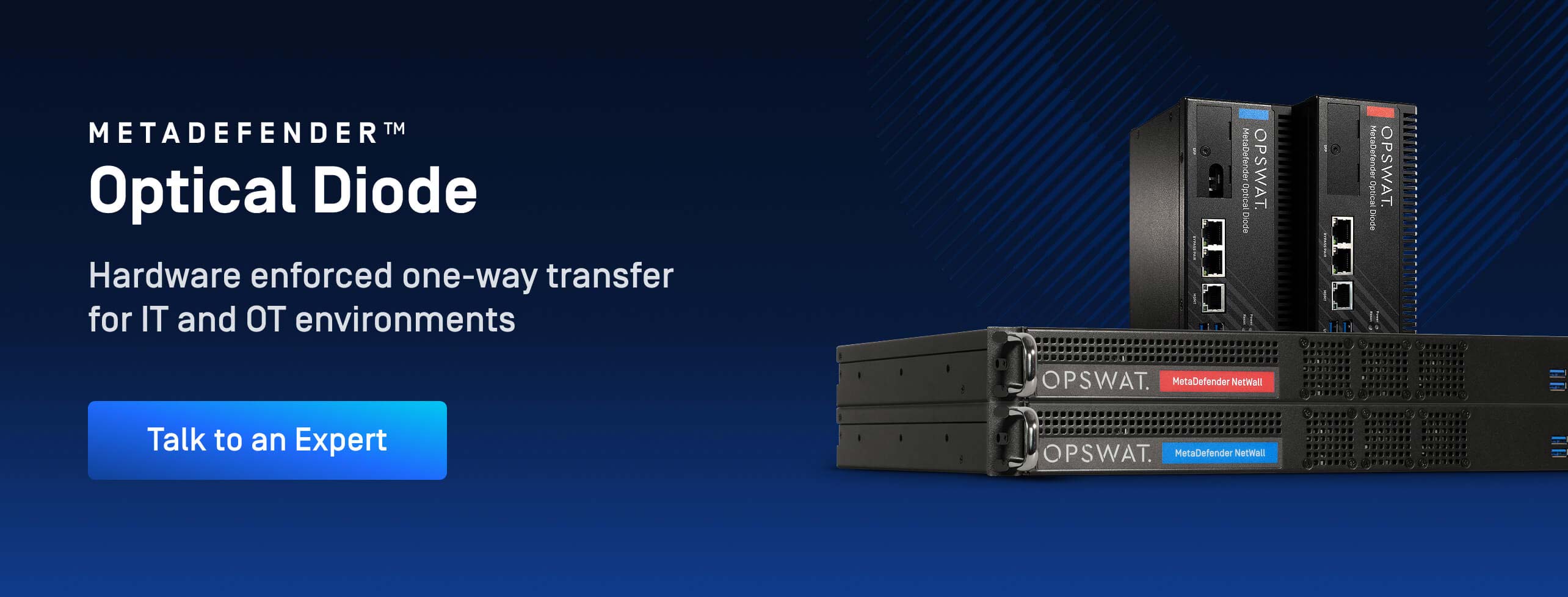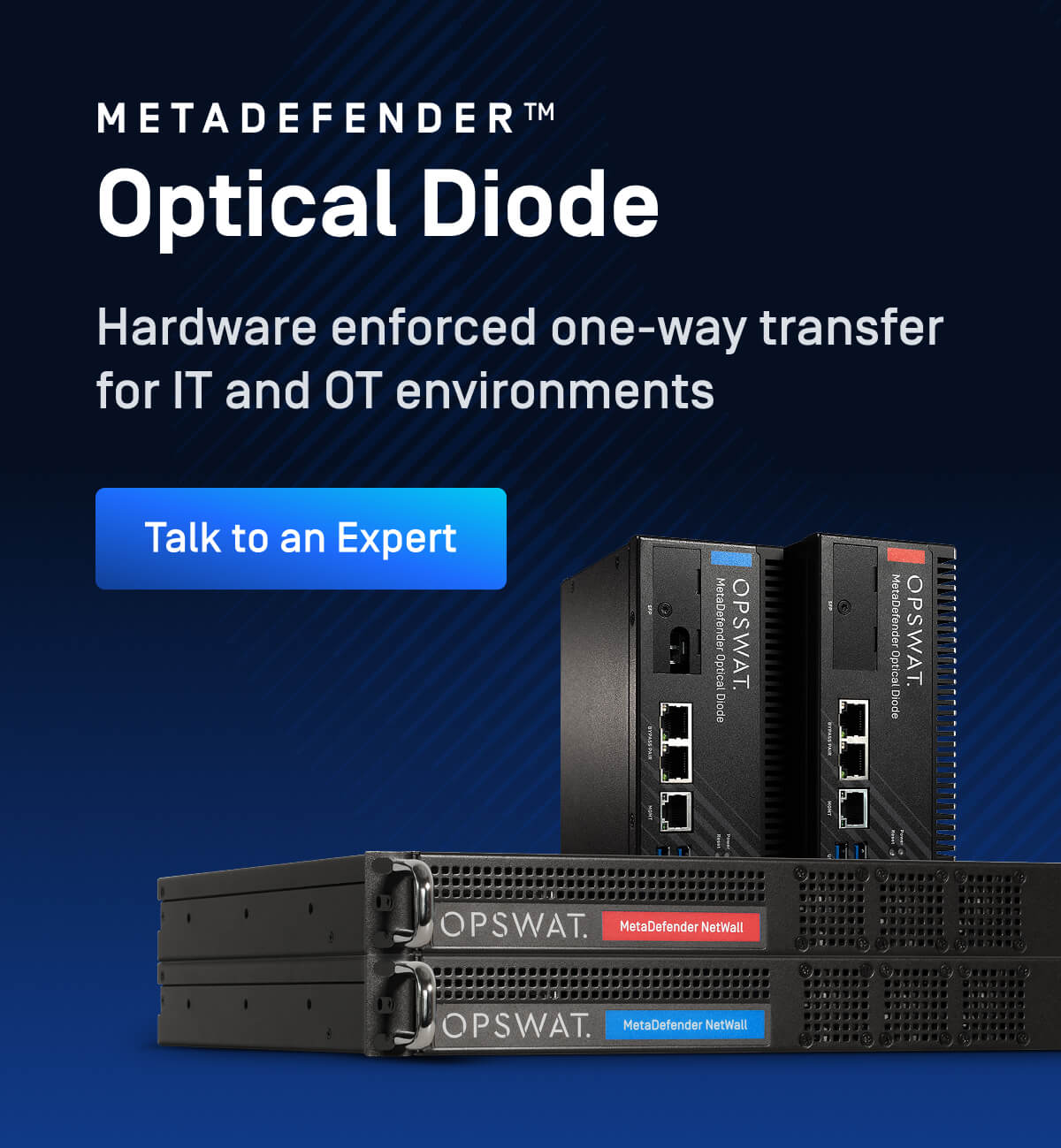Critical infrastructure—including energy grids, water treatment plants, oil & gas, transportation systems, and manufacturing—rely on data replication to meet operational, cybersecurity, and compliance needs. However, securely transferring logs and events from OT to IT environments presents a significant challenge.
Security operations teams, forensic analysts, and compliance officers all need OT logs to detect anomalies, respond to threats, and ensure regulatory compliance. But allowing direct IT access into OT environments creates unacceptable security risks, including:
- Pivot attacks where cybercriminals move from IT to OT networks
- Exfiltration of sensitive industrial control data
- Tampering with logs to cover attacker tracks
MetaDefender Optical Diode enforces one-way, hardware-enforced data replication, ensuring that SPLUNK logs are securely pushed from OT to IT—without creating an attack surface for adversaries.
How Critical Infrastructures Use SPLUNK Data Replication
| Industry | How SPLUNK Replication Helps OT Security |
| Power Generation, Transmission & Distribution | Send SCADA logs to SPLUNK for real-time anomaly detection and compliance monitoring for NERC CIP |
| Water Treatment | Send ICS and sensor logs to Splunk for real-time monitoring of water quality, operational anomalies, and to support compliance with local regulatory standards |
| Manufacturing | Aggregates logs and events for predictive maintenance. |
| Oil & Gas | Uses SPLUNK for performance tracking, security event correlation, and operational analytics. |
Who Needs OT Logs (and Why They Can’t Just “Log In”)
Security Operations Center (SOC) Analysts
- Need real-time OT logs for detecting intrusions, malware, and abnormal traffic.
- Direct IT-to-OT access could allow attackers to pivot and compromise industrial systems.
OT Security Teams
- Require security logs for forensic analysis and anomaly detection.
- IT-based security tools should not have inbound access to OT environments.
Incident Response & Forensic Teams
- Need logs to investigate attacks, contain threats, and prevent repeat incidents.
- If an attacker compromises IT-side tools with OT access, they could take control of industrial assets.
Compliance & Audit Teams
- Require long-term log storage and event tracking for audits (e.g., NERC CIP, IEC 62443).
- Direct OT access for auditors increases security risks.
Why does SPLUNK data need to be protected?
For organizations operating in critical infrastructure sectors, SPLUNK plays a vital role in aggregating, analyzing, and correlating data from ICS (industrial control systems), SCADA environments, and OT networks. However, ensuring the security, integrity, and controlled transfer of this data is paramount to maintaining operational resilience while preventing cyber risks.
Ensuring Trusted Network Segmentation & Secure Data Flow
Critical infrastructure requires 100% network confidentiality. Traditional network segmentation methods, such as firewalls and VPNs, can introduce risks through misconfigurations and evolving attack methods.
Eliminating External Access Points in Remote Monitoring
As remote monitoring increases, the risk of exposing OT networks to cyber threats grows. Bridging OT and IT networks can create vulnerabilities that attackers may exploit, including ransomware and advanced persistent threats.
Reducing Cost & Complexity of Software-Based Segmentation
Traditional solutions incur high maintenance costs and complex configurations. These can introduce errors, create additional overhead, and increase the risk of exposure due to misconfigurations or outdated defenses.
MetaDefender Optical Diode and SPLUNK Solution Use Cases
SPLUNK-to-SPLUNK Replication Over HTTP using MetaDefender Optical Diode HTTPS Connector
MetaDefender Optical Diode enhances SPLUNK-to-SPLUNK replication by using MetaDefender Optical Diode’s HTTPS connector, ensuring secure and encrypted data transfer across network boundaries. This integration supports the HTTP protocol, providing a secure, one-way data flow without compromising network security, making it ideal for environments requiring stringent cybersecurity measures.
Supported SPLUNK Replication Use Cases
MetaDefender Optical Diode supports multiple SPLUNK replication scenarios, ensuring data security and compliance in a variety of industrial environments. These use cases allow for flexible, secure data transfers between SPLUNK instances, whether from heavy forwarders, universal forwarders, or syslog systems.
Heavy Forwarder to Indexer

Universal Forwarder to Indexer

Syslog Source to Indexer

Overcoming Traditional Data Diode Challenges in SPLUNK Integration
Integrating MetaDefender Optical Diode (OPSWAT's data diode) with SPLUNK addresses several challenges traditionally associated with firewalls in SPLUNK data replication:
Preservation of SPLUNK Metadata
- Challenge: Historically, data diodes often strip or fail to transmit essential SPLUNK metadata (e.g., sourcetype, source, host, _time), leading to data integrity issues.
- Solution: MetaDefender Optical Diode ensures that all critical metadata is preserved during transmission, maintaining data integrity and usability within SPLUNK.
Elimination of Additional Software Modules
- Challenge: Implementing SPLUNK data replication through data diodes typically requires additional software modules or custom configurations, increasing complexity and cost.
- Solution: MetaDefender Optical Diode supports native SPLUNK-to-SPLUNK replication without the need for extra software, simplifying deployment and reducing expenses.
Support for Native SPLUNK Protocols
- Challenge: Many historically dated optical data diodes do not support SPLUNK's native protocols, necessitating protocol conversions that can introduce latency and potential errors.
- Solution: MetaDefender Optical Diode facilitates replication using SPLUNK's native protocols, ensuring seamless and efficient data transfer.
Secure Data Transfer Across Network Boundaries
- Challenge: Transferring data between networks of differing security classifications poses risks of data leakage or unauthorized access.
- Solution: MetaDefender Optical Diode enforces unidirectional data flow, securely transmitting SPLUNK data across network boundaries without compromising network integrity.
Reduction of Total Cost of Ownership (TCO)
- Challenge: Traditional data diode solutions often incur high costs due to complex configurations and ongoing maintenance requirements.
- Solution: By eliminating the need for additional modules and supporting native protocols, MetaDefender Optical Diode reduces both initial setup and long-term maintenance costs.
Security Without Compromise: Get SPLUNK Visibility Without The Risk
Security teams don’t have to choose between visibility and safety. MetaDefender Optical Diode ensures that critical OT security logs are securely available for IT monitoring—without exposing industrial networks to threats.
- No inbound IT access into OT environments
- Compliance with regulatory frameworks (NERC CIP, IEC 62443, NIST CSF)
- Secure, deterministic, and seamless SPLUNK integration
- Reduced operational complexity and costs
What is Splunk?
Splunk is a leading data analytics platform used for collecting, indexing, and analyzing big data, especially security logs. It’s a key tool in security operations for real-time monitoring, threat detection, and compliance reporting.
What is MetaDefender Optical Diode?
The MetaDefender Optical Diode is the core of the MetaDefender NetWall Security Gateway, enforcing a hardware-based, one-way data flow from OT to IT. It ensures critical data like logs and alerts leave the OT network without allowing any return path. As part of the MetaDefender NetWall family, it supports secure log replication, file transfers, and visibility for compliance—without compromising network isolation. The MetaDefender NetWall product line is designed to protect critical infrastructure while enabling safe, controlled data sharing.
Ensure reliable and secure data replication in your critical infrastructure with OPSWAT MetaDefender Optical Diode—talk to an expert today.



